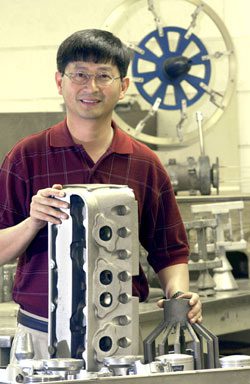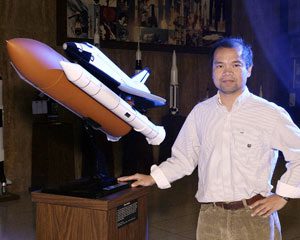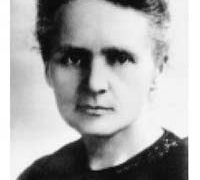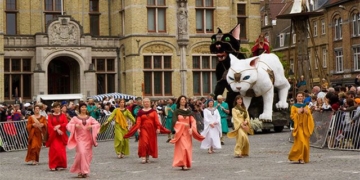Working for the National Aeronautics and Space Administration (NASA) is a dream for scientists worldwide. The Vietnamese mark has been prominently etched in many of NASA’s achievements over the past 40 years, from Dr. Nguyễn Xuân Vinh with his research on spacecraft trajectories to hundreds of Vietnamese experts from subsequent generations, including talents trained in Vietnam.
Eugene H. Trinh (Trịnh Hữu Châu), born in 1950 in Saigon, earned his Ph.D. in Applied Physics from Yale University in 1977 and was an astronaut on the Columbia Space Shuttle mission STS-50 in 1992, flying to the Skylab space station for a record 13-day mission – the longest of the entire shuttle program.
 |
|
Jonathan Lee (Điền Lê), born in 1959, semiconductor physicist and structural materials engineer (Photo: NASA) |
Jonathan Lee (Điền Lê), born in 1959, is a semiconductor physicist and structural materials engineer. He has worked for NASA since 1989 and is the inventor of the aluminum-silicon alloy for NASA, a material known for its high strength-to-weight ratio and low cost.
Diệp and Hữu Trịnh, a married couple from Bạc Liêu, both contribute to NASA. Diệp, born in 1963, is a structural materials engineer, while Hữu is an aerospace engineer, both working at NASA’s Marshall Space Flight Center. Diệp has participated in various projects, including the chemical analysis and surface study of X-ray telescope mirrors, while Hữu specializes in safety technology for spacecraft.
Bùi Trí Trọng, born in 1965 in Saigon, holds a Ph.D. in Aerospace Engineering from Stanford University. He officially joined NASA’s Glenn Research Center in 1997 as an aerospace engineer. He currently works at the Dryden Flight Research Center, focusing on research and testing various rocket types.
Bruce Vu (Thanh Vũ) earned his Ph.D. in Aerospace Engineering from Mississippi State University in 1999. He officially started working for NASA’s Marshall Center in 1988, specializing in the creation of computer simulation systems for studying fluid dynamics – the movements of gases and liquids that can affect shuttle operations, assembly, and launches. He is currently at NASA’s Kennedy Space Center in Florida, researching the application of nanotechnology to create computers the size of cells.
If you have the opportunity to visit the NASA Space Achievement Gallery at the NASA Flight Control Center in Houston, Texas, you will see the name of a Vietnamese individual honored: Professor – Dr. Nguyễn Xuân Vinh. At a time when most Vietnamese were still riding bicycles, Nguyễn Xuân Vinh’s research using mathematical theories paved the way for spacecraft to reach the moon.
 |
|
Bruce Vu (Thanh Vũ), Ph.D. in Aerospace Engineering from Mississippi State University in 1999 (Photo: NASA) |
NASA sponsored Nguyễn Xuân Vinh’s successful research on calculating optimal trajectories for spacecraft, which formed the basis for his doctoral thesis. He was the first Vietnamese and the first at the University of Colorado to receive a Ph.D. in Space Science in 1962 for this work. His theories played a crucial role in successfully landing the Apollo spacecraft on the moon and were later applied to the recovery of space shuttles returning to Earth.
Currently, we do not have a comprehensive count of how many Vietnamese work at NASA, but at the Ames Research Center in Moffett Field, California, there are over 100 Vietnamese experts. Astrophysicist Dr. Eugene H. Trinh (Trịnh Hữu Châu) works at NASA-JPL. Also at NASA-JPL, Dr. Nguyễn Thành Tiến received the NASA Exceptional Achievement Medal for significant contributions to the Galileo program that sent a spacecraft to explore Jupiter.
On the International Advisory Council for Space Data Systems at NASA-JPL is Dr. Nguyễn Mạnh Tiến. Jonathan Lee (Điền Lê) is at the Marshall Space Flight Center in Alabama. These are just some of the Vietnamese contributions at NASA from the generation born in the 1950s – the second generation following Nguyễn Xuân Vinh.
The generation born in the 1960s and later makes up the majority of the Vietnamese expert community at NASA. Dr. Bùi Trí Trọng currently works at the Dryden Flight Research Center in Edwards, California, focusing on research and testing various rocket systems.
Dr. Nguyễn Quang Việt works at the Glenn Research Center in Cleveland, Ohio, designing and testing diagnostic equipment for high-pressure hydrogen combustion chambers in rocket engines. Dr. Peter Ve Tran (Trần Vệ) is currently the program director for the Spacecraft Pressure Vessel Program at the Stennis Space Center in Bay St. Louis, Missouri…
In 2004, Đinh Bá Tiến, then just 25 years old and pursuing a Ph.D. in Computer Science at the University of Huddersfield in the UK, triumphed over hundreds of other candidates globally and was recruited into NASA’s artificial intelligence research program to develop software for controlling robots and autonomous spacecraft.
Before moving to the UK, Đinh Bá Tiến was a lecturer at the University of Natural Sciences in Ho Chi Minh City. The Vietnamese mark at NASA has begun to include talents trained right in Vietnam.


















































